|
|
Celestron C11 280/2800mm OTA OPTICAL ANALYSIS
Wade
Van Arsdale
Little Rock, AR., USA
March 22nd, 2010
|
|
I. Optical Analysis:
Strehl and Wavefront Error Testing
Test
Date: March 22nd, 2010
Skies: Clear
Seeing: 6 out of 10, with some interference in atmospheric steadiness from
jet-stream
Transparency: 9 out of 10
Temperature: 47 degrees F
Dewpoint: 44 degrees
Wind: N, 5-10 mph
Test camera: Lumenera SKYnyx 2-2C webcam with Baader IR/UV cutoff filter @
320 x 240 image size, 41 fps capture rate for 1000 frames each, and resolution
of 0.75 arc-sec/pixel
Optical Analysis Software Used: WinRoddier
The
Celestron C11 OTA tested out with a very good Strehl value of 0.937, as measured
mid-bandwidth in the Green (approximately 550 nm wavelength) as the reference
point. This
corresponds to a P-V wavefront error of approximately 1/6th wave at the camera
chip, which is very good. Considering that a P-V value of 1/4 wave is
considered to be diffraction-limited, 1/6th wave is better than
diffraction-limited in optical performance. This means that in all types
of atmospheric seeing conditions no matter how good, the telescope's performance
will only be limited by the atmospheric seeing itself and never limited by the
telescope's optics. The
lesser correction in the blue wavelengths is the primary limiting factor keeping
this scope from being a top-notch sample from Celestron. Overall,
the C11 tested out as a very good performer both visually and for deep-sky
imaging as well as for planetary webcamming. With the glass being better
corrected in the Green and Red wavelengths where most of the visual detection of
the eye is found, I expect this scope to be a better performer for visual use
than for imaging use. Some "blue-bloat" on stars with CCD
imaging might be seen with this OTA, but can be mitigated to a some extent by
using a monochrome CCD camera with separate color filters and refocusing with
each filter change to improve focus sharpness.
See Roddier tests below for each individual wavelength specifics.
Reference Chart for Strehl Values and P-V Wavefront Errors. Chart courtesy of R.F. Royce Precision Optical Components:
|
Commonly Encountered Wavefront Relationships |
||||
| P-V Fraction | P-V Decimal | Marechal RMS* | Strehl Ratio | Comments |
| 1/3 | .333 | .094 | .71 | |
| 1/4 | .250 | .071 | .82 | Rayleigh Limit |
| 1/5 | .200 | .057 | .88 | |
| 1/6 | .167 | .047 | .92 | Good |
| 1/7 | .143 | .041 | .94 | Very Good |
| 1/8 | .125 | .036 | .95 | Excellent |
| 1/9 | .111 | .032 | .960 (.96) | Excellent |
| 1/10 | .100 | .028 | .969 (.97) | Excellent |
| 1/11 | .091 | .026 | .974 | |
| 1/12 | .024 | .024 | .978 | "Super Apo" |
Strehl
Test Results:
Green
(reference): Ronchigram (white
test pattern below) shows some undercorrection and a very good
Strehl value of 0.937, which corresponds to a wavefront error
of 1/6th wave, which is well below diffraction-limited. The
undercorrection will tend to shift toward the Blue wavelengths and improve
in the Green as the glass temp equalizes.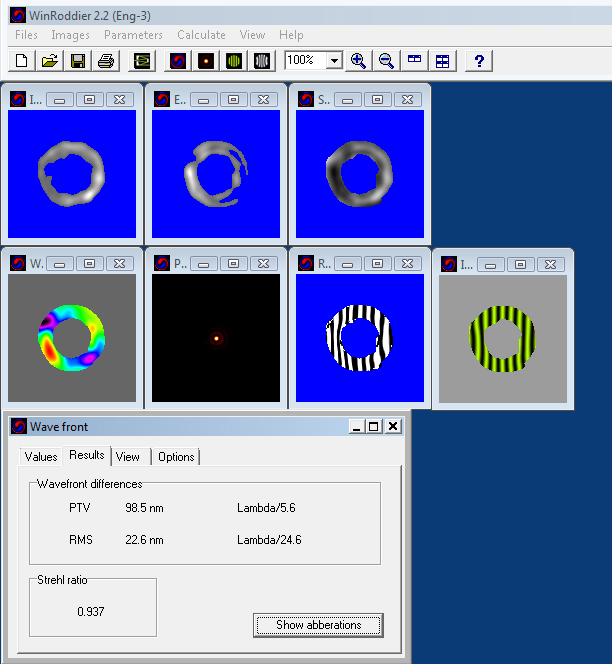
|
Red:
Ronchigram shows some slight undercorrection
in the red wavelengths. Slight undercorrection is usually not a
problem because it tends to correct itself to some extent as the glass
cools down to equilibrium with outdoor ambient temperature. The
Strehl value recorded is 0.945 which is very good and corresponds to 1/7th
wave P-V.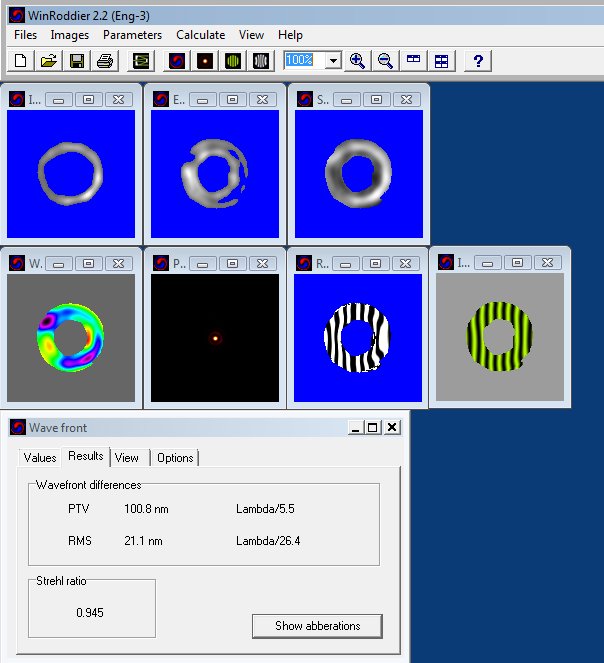 |
Blue:
Some overcorrection in the blue wavelength
is noted, and limits the Strehl in Blue to .908. This
problem will be the main limiting factor in performance of the OTA, but
its performance will still be well above diffraction-limited at 1/6th wave
or better overall. The overcorrection in Blue may even get better slightly as the glass temp reaches equilibrium.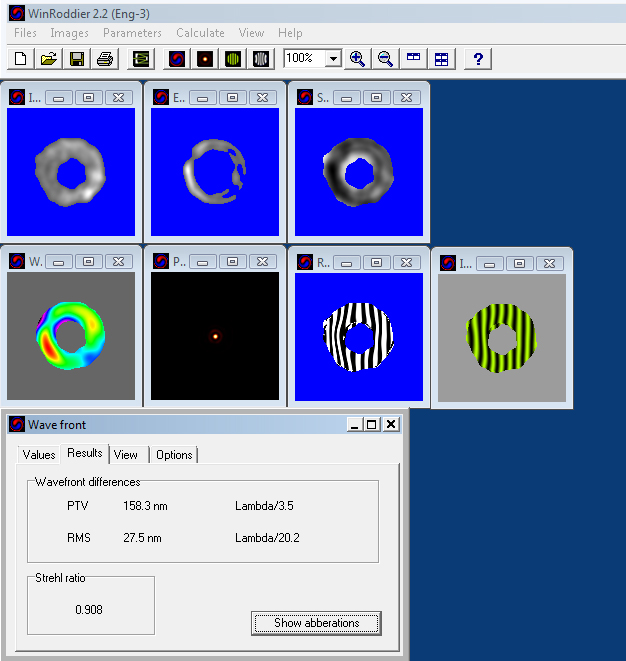 |
II. Hi-resolution webcam image of Jupiter with the C11:
Camera: Lumenera SKYnyx 2-2C webcam with Baader IR/UV cutoff filter
|
|
III. Collimation Testing
Equipment Used:
SBIG ST-2000XM CCD Camera.
SBIG CFW8 filter wheel. All CCDI test frames shot through Custom Scientific
(L-layer) clear filter with IR cutoff.
TMB Optical 152/1200mm OTA
Mount Used: Astro-Physics AP1200GTO
Collimation method used: Visual star test at near-zenith on live
star.
CCD
Inspector Software by CCDWare
Curvature, Tip/Tilt, and Collimation all very
good and produced round stars
across the entire FOV.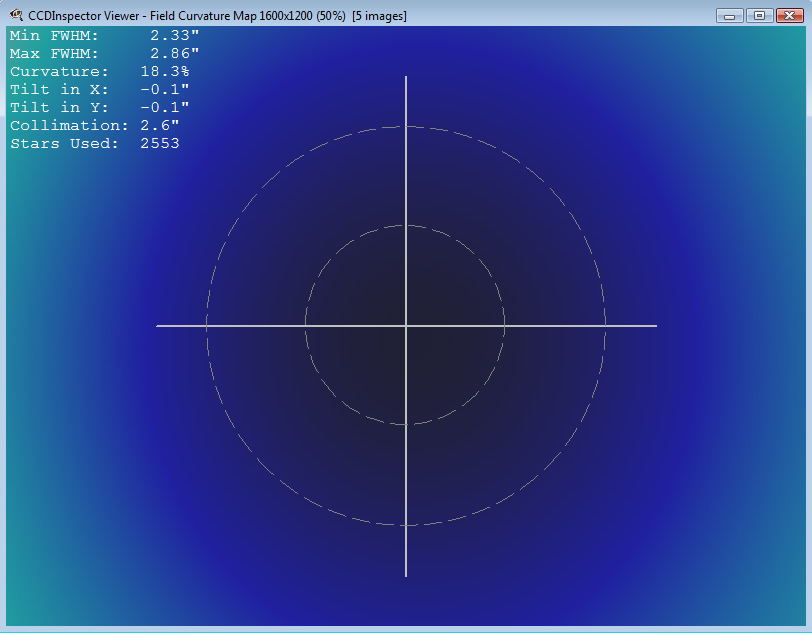 |
Frames used for analysis. FWHM and Aspect values all
very good.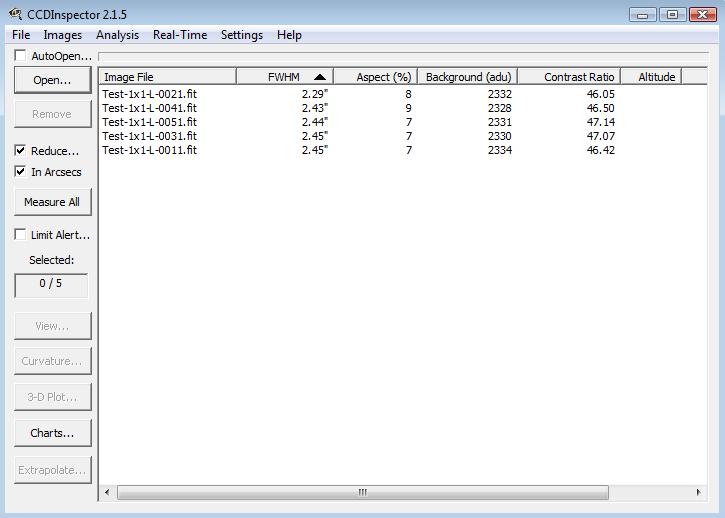
|
Conclusion:
The
Celeston C11 OTA arrived here out of collimation (typical in my experience) and in
excellent overall mechanical and cosmetic condition from the vendor. The
visual star test showed good control of chromatic aberration with some
spherochromatic aberration present in amounts that are typical of SCT's.
Focus sharpness from the SA is typical of most SCT's: good but not
"snap-in sharp" like a good refractor, but still acceptable.
Focusing performance at high magnitude both on planets and visual deep-sky
observing was helped greatly by the use of a Feathertouch dual-speed
crayford focuser. This
telescope performed well for for high-resolution planetary webcam imaging and
high-magnitude visual planetary observations.
It also performed very well for deep-sky visual observations which is probably
the best use for this OTA. The SA and CA present in this sample have only
minimal effects on performance at lower magnification on deep sky objects with
this OTA. I have not evaluated it yet as a deep-sky imaging scope but will
add data when it's available.
This C11 is not one of the "pick of the litter" glass samples that you hear about Celestron producing once in awhile, but nonetheless, overall performance ranged from good to very good visually and on high-resolution planetary webcamming.
It is possible that this OTA will give better performance with the use of forced cooling with fans. At some point in the near future, I plan to re-evaluate it after using forced cooling on it with a Lymax Cat Cooler fan and optimal seeing conditions, to see what effect this has on its performance. I expect it to do a little better in more optimal test conditions. For this initial round of tests, I wanted to test it the way it would be used by most people most of the time: under less than ideal atmospherics with glass and tube thermals not fully cooled down and equalized to ambient temp yet.
Wade Van Arsdale
Little Rock, AR., USA
April 20th, 2010